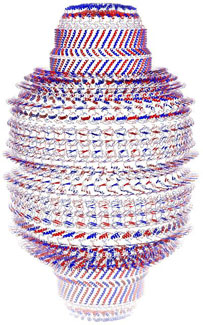| Posted: November 26, 2007 |
Researchers outline structure of largest nonvirus particle ever crystallized |
|
(Nanowerk News) Researchers at UCLA's California NanoSystems Institute, the David Geffen School of Medicine at UCLA and the Howard Hughes Medical Institute have modeled the structure of the largest cellular particle ever crystallized, suggesting ways to engineer the particles for drug delivery.
|
|
The research study, which focuses on new engineered nanomaterial vaults for use as a drug-therapy vehicle, appears in the Nov. 27 edition of the peer-reviewed, open-access journal PLoS Biology, published by the Public Library of Science, and is available at http://biology.plosjournals.org.
|
|
The team of researchers at UCLA is led by David Eisenberg and Leonard H. Rome of the departments of biological chemistry at the Geffen School of Medicine and the California NanoSystems Institute and associate researchers Daniel H. Anderson, Valerie A. Kickhoefer and Stuart A. Sievers. Eisenberg, Anderson and Sievers are also members of the Howard Hughes Medical Institute and the UCLA–U.S. Department of Energy Institute for Genomics and Proteomics.
|
|
Vaults are large, barrel-shaped particles found in the cytoplasm of all mammalian cells; they may function in innate immunity. As naturally occurring nanoscale capsules, vaults may be useful to engineer as therapeutic delivery vehicles. For the study, the team of researchers proposed an atomic structure for the thin outer shell of the vault.
|
 |
| Model of the vault derived by UCLA researchers, with applications to drug delivery (figure published in Nov. 27, 2007, PLoS Biology).
|
|
Using X-ray diffraction and computer modeling, the research team developed a draft atomic model for the major vault protein, which forms the shell-like enclosure of the vault.
|
|
"Our draft model is essentially an atomic-level vault with a completely unique structure, like a barrel with staves. It is unlike any other large structure found in nature," Rome said. "The outside of the vault structure is like an eggshell — a continuous protective barrier with no gaps."
|
|
The shell is made up of 96 identical protein chains — each made of 873 amino acid residues — folded into 14 domains. Each chain forms an elongated stave of half the vault, as well as the cap of the barrel-like shell.
|
|
"These nanostructured vaults offer a human-friendly nanocontainer, like a molecular-level C-5A transport jet, with a cargo hold large enough to encompass a whole ribosome with its hundreds of proteins and nucleic acids, or enough drugs to control a cell," Eisenberg said.
|
|
The construction of the draft atomic model lays the foundation for further studies of vaults and will guide vault engineering projects focused on the targeted release of vault contents for drug delivery.
|
|
The research is supported by a National Science Foundation Nanoscience Interdisciplinary Research Team Grant, the Howard Hughes Medical Institute, the National Institutes of Health and the Department of Energy.
|
|
The California NanoSystems Institute is a multidisciplinary research center at UCLA whose mission is to encourage university-industry collaboration and enable the rapid commercialization of discoveries in nanosystems. CNSI members include some of the world's preeminent scientists, and the work conducted at the institute represents world-class expertise in five targeted areas of nanosystems-related research: renewable energy; environmental nanotechnology and nanotoxicology; nanobiotechnology and biomaterials; nanomechanical and nanofluidic systems; and nanoelectronics, photonics and architectonics. For additional information, visit www.cnsi.ucla.edu.
|
|
UCLA is California's largest university, with an enrollment of nearly 37,000 undergraduate and graduate students. The UCLA College of Letters and Science and the university's 11 professional schools feature renowned faculty and offer more than 300 degree programs and majors. UCLA is a national and international leader in the breadth and quality of its academic, research, health care, cultural, continuing education and athletic programs. Four alumni and five faculty have been awarded the Nobel Prize.
|

